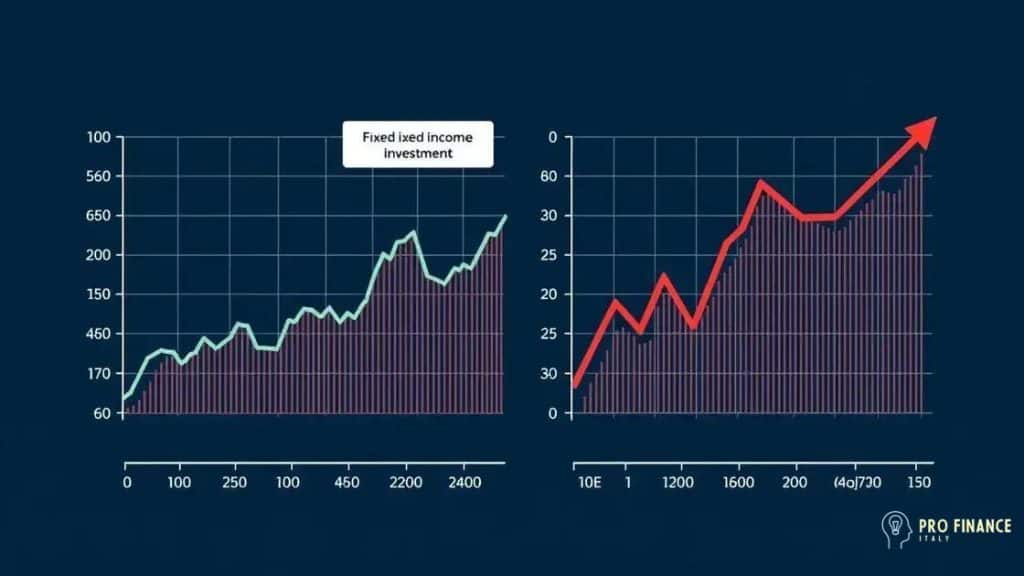Risks of inflationary pressures on fixed-income investments

The risks of inflationary pressures on fixed-income investments can diminish purchasing power and returns, making it essential to diversify portfolios and explore alternatives such as equities, real estate, and inflation-protected securities.
Risks of inflationary pressures on fixed-income investments can impact your financial strategy significantly. Have you ever wondered how rising prices affect your savings and investment returns? This article dives into the heart of this issue, helping you navigate these economic challenges.
Understanding inflationary pressures
Understanding inflationary pressures is crucial for anyone invested in the economy. Inflation refers to the general increase in prices over time, which can have significant impacts on purchasing power and investments. When inflation rises, the value of money decreases, meaning that the same amount of money buys fewer goods and services than before.
Causes of Inflation
Several factors contribute to inflation. These include:
- Demand-pull inflation: Occurs when demand for goods exceeds supply.
- Cost-push inflation: Happens when production costs rise, leading to higher prices for consumers.
- Built-in inflation: Results from businesses increasing prices due to higher wage demands.
The challenges posed by inflationary pressures are especially relevant to fixed-income investments. Investors must be aware of how these pressures can affect their returns.
Effects on Investments
As inflation rates climb, the buying power of interest payments from fixed-income investments diminishes. For instance, bonds that pay a fixed interest rate become less attractive if inflation outpaces that rate. Essentially, if inflation is at 3% and the bond pays 2%, you are effectively losing money in real terms. It’s crucial for investors to monitor inflation and adjust their strategies accordingly.
In addition to bonds, other fixed-income securities can also feel the pinch. Investors should consider diversifying their portfolios to include assets that align better with inflationary expectations.
Strategies to Protect Against Inflation
To counteract the risks of inflation, investors can:
- Consider inflation-linked bonds: These adjust interest payments with inflation rates.
- Diversify across asset classes: Including stocks and real estate which may outperform during inflationary periods.
- Invest in commodities: Such as gold or oil, known to maintain value during inflation.
By understanding inflationary pressures and their implications, investors can make informed decisions that protect their investments and wealth.
Impact on fixed-income investments
The impact on fixed-income investments from inflation is a critical topic for any investor. As inflation rises, the real value or purchasing power of interest payments diminishes, impacting returns. This situation requires a careful assessment of how inflation affects various fixed-income vehicles.
Effects of Rising Inflation
When inflation increases, bondholders often find their fixed interest payments less valuable. For example, if a bond pays a fixed interest of 5% and inflation is at 3%, the real return is only 2%. This situation can lead to a decline in demand for fixed-income securities, as investors seek better returns elsewhere.
It’s important to understand how different types of bonds react to inflation. Government bonds, for instance, often take longer to show effects, while corporate bonds may react more quickly due to concerns about profitability and cash flow.
Strategies for Investors
Investors can use various strategies to cope with the impact on fixed-income investments.
- Invest in floating-rate bonds: These bonds can adjust interest rates according to market conditions, helping safeguard against inflation.
- Consider TIPS: Treasury Inflation-Protected Securities (TIPS) are designed to rise with inflation, protecting buyers from the devaluation of their holdings.
- Diversify your portfolio: Expanding your investments to include stocks or real assets can provide a hedge against inflation.
By implementing these strategies and staying informed about inflation trends, investors can better position themselves to navigate the challenges posed by rising prices.
Strategies to mitigate risks
Finding effective strategies to mitigate risks associated with inflation is essential for protecting investments, especially fixed-income ones. As inflationary pressures increase, investors must adapt their strategies to safeguard their portfolios.
Diversification is Key
One popular method to reduce risk is diversification. By spreading investments across different asset classes, such as stocks, real estate, and commodities, investors can limit the impact of inflation on their overall portfolio. A well-diversified portfolio tends to perform better during economic fluctuations.
Consider Inflation-Protected Securities
Inflation-protected securities, like Treasury Inflation-Protected Securities (TIPS), adjust their principal value based on inflation rates. This means that when inflation rises, so does the value of these investments. Investing in TIPS can help ensure that your investments keep pace with inflation over time.
Utilize Floating-Rate Bonds
Another viable option is floating-rate bonds. These bonds can offer higher interest payments when inflation rises. They provide a hedge against the eroding value of fixed-rate bonds, making them an attractive choice during inflationary periods.
Additionally, it may be beneficial to include assets like commodities and real estate in your investment strategy. These can often outperform during times of high inflation, adding a layer of protection to your portfolio.
Stay Informed
Lastly, staying informed about economic indicators is crucial. Regular monitoring of inflation trends will provide insights into when to adjust your investment strategies. Awareness allows investors to respond promptly to changing economic conditions.
Market trends and forecasts

Analyzing market trends and forecasts is essential for understanding how inflation factors into the financial landscape. Keeping an eye on these trends helps investors make informed decisions based on economic indicators.
Current Market Trends
One significant trend is the anticipated rise in interest rates as central banks respond to inflationary pressures. Higher interest rates can lead to lower bond prices, affecting fixed-income investments. Therefore, investors should watch for changes in monetary policy that can signal these shifts.
Key Economic Indicators
Several economic indicators impact market trends and provide insights into future inflation. Some of these include:
- Consumer Price Index (CPI): Measures overall inflation by tracking changes in the price of a basket of goods and services.
- Producer Price Index (PPI): Focuses on changes in the prices producers receive for their products, often a precursor to consumer price changes.
- Gross Domestic Product (GDP): Indicates the overall economic activity and growth; a booming economy can lead to higher inflation.
By paying attention to these indicators, investors can better gauge the potential impact on fixed-income investments and make proactive adjustments to their strategies.
Forecasting Future Trends
Forecasts for inflation can vary based on current economic conditions. Experts often predict that inflation may remain elevated in the near term due to ongoing supply chain issues and high demand in various sectors. This environment could prompt investors to reconsider their asset allocations, particularly regarding fixed-income securities.
It’s crucial for investors to stay updated on market analyses and professional predictions about inflation trends. Engaging with finance news and analysis will help refine investment strategies in response to changing market dynamics.
Alternatives to fixed-income investments
Exploring alternatives to fixed-income investments is important for investors looking to diversify their portfolios and protect against inflation. While fixed-income investments provide stability, they may not always provide the best returns, especially during high inflation periods.
Equities
One popular alternative is to invest in equities. Stocks can offer higher potential returns compared to bonds, particularly in a growing economy. While they come with greater risk, they also have the potential for substantial gains that can outpace inflation.
Real Estate
Investing in real estate is another effective alternative. Properties can generate rental income and appreciate in value over time. Real estate investments can also serve as a hedge against inflation, as property values and rents often rise with inflation rates.
Commodities
Commodities, such as gold and oil, can also serve as alternatives to fixed-income investments. These tangible assets often retain value during inflationary periods. Many investors look to commodities to protect their portfolios from market volatility and currency devaluation.
Mutual Funds and ETFs
Another option is to invest in mutual funds or exchange-traded funds (ETFs) that focus on sectors expected to perform well in inflationary environments. These funds can provide exposure to stocks, commodities, and real estate, offering diversification and professional management.
Ultimately, considering a mix of these alternatives to fixed-income investments can lead to a more balanced and resilient investment strategy, tailored to withstand varying economic conditions.
FAQ – Frequently Asked Questions about Inflation and Fixed-Income Investments
What are inflationary pressures and why do they matter?
Inflationary pressures refer to the factors that cause prices to rise in the economy. They matter because they can erode the purchasing power of investments, particularly fixed-income securities.
How can I protect my fixed-income investments from inflation?
You can protect your investments by diversifying your portfolio, investing in inflation-protected securities like TIPS, or considering alternatives like equities and real estate.
What are some effective strategies to mitigate risks during inflation?
Effective strategies include maintaining a diversified portfolio, investing in floating-rate bonds, and regularly reviewing your investment strategy in light of economic trends.
What are some alternatives to fixed-income investments?
Alternatives include equities, real estate, commodities, and mutual funds or ETFs that focus on sectors expected to perform well during inflationary environments.





